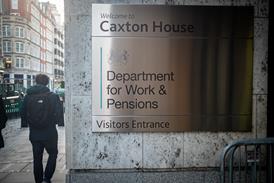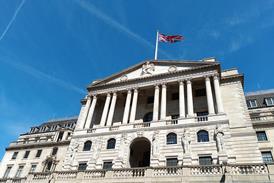Three years on from the drama of the so-called ‘mini-Budget’, Pensions Expert looks back on events and what has changed – as well as looking to where the next big challenges could come from.
This week (23 September) marks three years since then-chancellor Kwasi Kwarteng delivered the Conservative government’s ‘Growth Plan 2022’. It cancelled a planned increase in corporation tax and cut other taxes with few specifics about how this would be funded.

The move spooked bond markets and sent gilt yields spiralling and the value of the pound crashing. Falling government bond prices in the days after the announcement triggered margin calls on liability-driven investment (LDI) strategies that used leverage, requiring some defined benefit (DB) pension schemes to seek emergency funding from employers.
The gilt market movements were so severe that the Pensions Regulator appealed to the Bank of England to intervene. On 28 September 2022, the bank began buying UK government bonds in an effort to stabilise prices, eventually purchasing almost £14bn worth of gilts.
Companies including National Grid and Morgan Advanced Materials provided additional funding to their pension schemes to help them through the market instability. Even the Pension Protection Fund (PPF) had to provide approximately £1.6bn in cash for additional security linked to its LDI programme, according to a Financial Times report in October 2022.

From the archive: Seven days in pensions
On 30 September 2022, Broadstone’s David Brooks gave an insight into bond market movements in the wake of the ‘mini-Budget’ and how LDI strategies and hedging positions were affected. Read the full article
A changed conversation for DB schemes
Isio chief investment officer Barry Jones says DB pension schemes “are in a much stronger position” than they were through the mini-Budget crisis. They have been aided by higher interest rates – the Bank of England raised rates 13 times during 2022 and 2023 – and a recovery in risk assets.
“Schemes are holding more gilts and high-quality credit, while reducing leverage in their liability-driven investment portfolios,” Jones explains. “The new Funding Code will only accelerate this shift towards greater stability. Furthermore, the conversation has moved on from how to get to full funding to a conversation of surplus sharing between sponsor and members, and running on.”
The PPF’s 7800 index of private sector DB pension schemes shows a significant improvement in overall funding levels over the past five years, based on the level needed to secure PPF-equivalent compensation.
How the pension scheme landscape has changed

At the end of 2019, just before the UK’s formal exit from the European Union, the PPF 7800 index showed an overall funding level of 99.4%, with £1.7trn of assets held against almost exactly the same value of liabilities.
As the impact of the Covid-19 pandemic and national lockdowns hit, funding declined to 92% in June, before recovering broadly in line with the UK’s economic recovery. By the end of 2021, the index’s funding level was 107.7%.
During the summer of 2022, prime minister Boris Johnson resigned, with Liz Truss named as his successor by Conservative Party members. However, the controversial Growth Plan undermined confidence in her leadership, and she too resigned on 25 October 2022, replaced by Rishi Sunak. By this point, the PPF’s funding level had spiked to 137.6%.
Since then, liabilities have dropped below £1trn and assets are heading in the same direction, aided by a change in the PPF’s methodology for the 7800 index brought in during 2023. Since January 2024, the overall funding level has mostly ranged between 123% and 129%.
Bank, TPR work to avoid repeat of liquidity crunch
Over the past three years, the Pensions Regulator has introduced more guidance – as well as a new Funding Code – to help trustees better manage LDI strategies and hedging programmes.
It has encouraged schemes to hold higher collateral buffers, and leverage in general in LDI strategies has fallen.
“Schemes now run with much larger buffers… The question is whether these safeguards are more than just a comfort blanket.”
Barry Jones, Isio
In January this year, the Bank of England launched the Contingent Non-Bank Financial Institution Repo Facility, specifically designed to support pension funds and LDI managers at times of market stress. The facility “will only be activated during episodes of severe gilt market dysfunction”, the bank said.
A report published by the bank late last year explained that the “financial and operational resilience” of LDI funds and strategies had improved since 2022.
Leverage has been reduced significantly since then, the report stated, while many LDI clients had set up “waterfall” arrangements to give managers access to a supply of liquid assets if further collateral is required.
Isio’s Jones says: “LDI looks different today. Schemes now run with much larger buffers to avoid the kind of forced gilt sales that dominated headlines in 2022. The question is whether these safeguards are more than just a comfort blanket.
“In the last bout of volatility, managers often asked for more collateral rather than relying on buffers. Repurchase agreements offer an extra backstop, but whether the system can truly withstand another shock remains to be seen.
“The system feels safer today, but the real test will be how these new safeguards perform in the event of another bond crisis. Understanding how and when buffers can be used will be key to avoiding history repeating itself.”
Attention turns to November Budget

The next big test of the gilts market could come at the end of November, when chancellor Rachel Reeves delivers her next Budget. The UK faces a significant deficit and rumours are rife as to how the government could seek to bridge this gap.
Richard Carter, head of fixed interest research at Quilter Cheviot, explains that a combination of weak economic growth and stubbornly high inflation was likely fuelling concerns around more gilt market volatility.
He adds that the government’s inability to push through spending cuts had also “damaged fiscal credibility and raised expectations of further significant tax rises”.
“While gilt markets have calmed in recent weeks, as we approach the budget in November, tensions will begin to rise once again.”
Richard Carter, Quilter Cheviot
“While the UK is not alone in its fiscal challenges, rising bond yields represent something of a vicious cycle for the government as they increase the cost of servicing existing debt, and for this government it is an issue it needs to get a hold of before market sentiment sours further,” Carter says. The government is expected to spend £110bn on debt interest in the 2025-26 financial year.
However, he points out that confidence has not been “well and truly lost” as it was in 2022 and the risk of a similar response in bond markets “remains low”.
“It could easily be, however, a more slow-motion effect in this instance – particularly if yields keep on rising in the medium term,” Carter says.
He adds: “While gilt markets have calmed in recent weeks, as we approach the budget in November, tensions will begin to rise once again. It is a delicate act that Reeves needs to produce, and markets may just start pressuring for results sooner rather than later.”






















